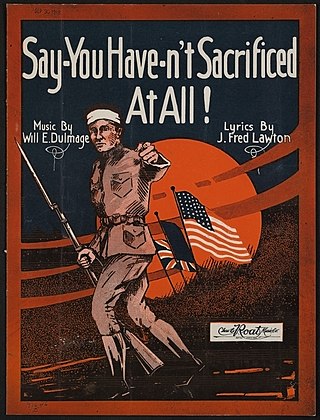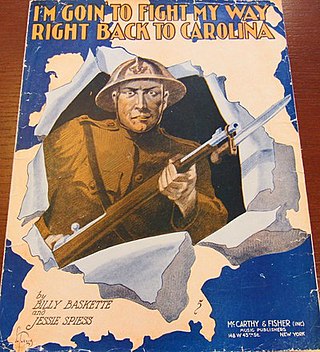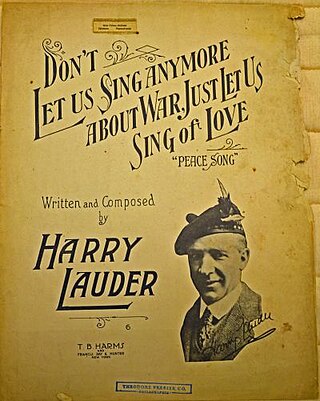
Our Country's in It Now! is a World War I era song released in 1918. Arthur Guy Empey wrote the lyrics. Charles R. McCarron and Carey Morgan composed the music. The song was published by Jos. W. Stern & Co. of New York, New York. On the cover, on both the left and right side, are drawings of soldiers engaged in trench warfare. In the center is a photograph of Arthur Guy Empey dressed in uniform. It is written for voice and piano.

There's a Service Flag Flying at Our House is a World War I era song released in 1917. The lyrics were written by Thomas Hoier and Bernie Grossman. Al W. Brown composed the music. The song was published by Joe Morris Music Co. of New York, New York. The Starmer Brothers designed the art featured on the sheet music. On the cover are soldiers marching down a street. Crowds of people cheer them on, and service flags wave above them.

A Mother's Prayer for Her Boy Out There is a World War I era song released in 1918. Andrew B. Sterling wrote the lyrics and Arthur Lange composed the music. It was written for voice and piano.

"That's a Mother's Liberty Loan" is a World War I era song released in 1917. Clarence Gaskill, Harry Tally, and Harry Mayo wrote the lyrics and composed the music. The song was published by M. Witmark & Sons of New York City. On the cover is a vitagraph photo of actors Edward Earle and Mary Maurice facing one another. The song was written for both voice and piano. It was performed by Greek Evans.

"Say, You Haven't Sacrificed at All! (March)", also written as "Say-You Haven't Sacrificed at All!" or "Say-You Have-n't Sacrificed at All!", is a World War I era song released in 1918. Most sources have attributed the role of composer to Will E. Dulmage and lyricist to J. Fred Lawton, as it is credited on the sheet music cover. One source has their roles reversed, and another source claims both composed the music. The song was published by Chas E. Roat Music Co. of Battle Creek, Michigan. On the cover is a soldier with a head wound, pointing. Behind him are British, French, and American flags. It was written for both voice and piano.

"You Great Big Handsome Marine" is a World War I era song released in 1918. Most sources solely credit Harold Dixon as both the composer and lyricist, as it is listed on the sheet music. Other sources give composer credit to Dixon and lyricist credit to I. Chapman. The song was published by Dixon-Lane Publishers of St. Louis, Missouri. On the cover is a soldier standing at attention. A battleship is behind him, and planes are flying overhead. The song was written for both voice and piano.

"When a Blue Service Star Turns to Gold" is a World War I era song released in 1918. Caspar Nathan wrote the lyrics. Theodore Morse composed the music. Leo Feist, Inc. of New York, New York published the song. Featured prominently on the sheet music cover is a service star. Beneath it are soldiers charging with artillery, a tank, and a plane. It was written for both voice and piano.

"My Sweetheart Is Somewhere in France" is a World War I era song first released in 1917. Mary Earl composed the music and wrote the lyrics. Shapiro, Bernstein & Co. Inc. of New York City published the song. Elizabeth Spencer performed a version of the song that was released by the Victor record label.

"Gee! What a Wonderful Time We'll Have When the Boys Come Home" is a World War I era song released in 1917. Lyrics and music were written by Mary Earl. The song was published by Shapiro, Bernstein & Co. of New York, New York. It was written for both voice and piano. The sheet music cover was designed by artist Albert Wilfred Barbelle. On the cover are soldiers marching down a city street. A skyline is behind them, and the lights spell out, "Welcome Home."

"I'm Goin' To Fight My Way Right Back to Carolina" is a World War I era song written and composed by Billy Baskette and Jessie Spiess. The song was published in 1918 by McCarthy & Fisher, Inc. of New York, New York. The sheet music cover was designed by Andre C. De Takacs. It features an armed soldier tearing through the cover. The song was written for both voice and piano.

"So Long, Mother" is a World War I era song released in 1917. Raymond B. Egan and Gus Kahn wrote the lyrics. Egbert Van Alstyne composed the music. The song was published by Jerome H. Remick & Co. of Detroit, Michigan. On the cover is a soldier and mother in an embrace. To the left is an inset photo of singer Al Jolson. It was written for both voice and piano.

"Lorraine " is a World War I era song released in 1917. Al Bryan wrote the lyrics. Fred Fisher composed the music. It was published by McCarthy and Fisher, Inc.. André De Takacs designed the sheet music cover. It features a French soldier with his bayonet drawn in the foreground. A woman, who is a symbol of Liberty, and child look on behind him. The song was written for voice and piano.

"Somewhere in France Is Daddy" is a World War I era song released in 1917. Lyrics and music were written by "Great Howard," otherwise known as Howard Miller. It was published by Howard & LaVar Music Co. of New York, New York. There are two versions of the sheet music cover. Both feature a mother holding a child, soldiers firing from a trench, and an inset photo of Great Howard. The latter version is a darker blue and the photo is of Howard in kilts. The song was written for both voice and piano.

"Tom, Dick and Harry and Jack " is a World War I era song released in 1917. Howard Johnson wrote the lyrics. Milton Ager composed the music. The song was published by Leo Feist, Inc. of New York City. Artist Henry Hutt designed the sheet music cover. It features four men in different service uniforms with an inset photo of either Jack Connors, Jr. or Bailey and Cowan. The inset photo varies by edition. It was written for both voice and piano.

"Say a Prayer for the Boys "Out There"" is a World War I era song released in 1917. Bernie Grossman wrote the lyrics. Alex Marr composed the music. It was published by Joe Morris Music, Co. of New York, New York. The sheet music cover was designed by the Starmer Brothers. It features a family praying at the dinner table. Behind them is a sentry guarding a campground of tents. There is an inset photo on the left side that varies per edition. The song was written for both voice and piano.

"Bring Back My Daddy To Me" is a World War I era song released in 1917. William Tracey and Howard Johnson wrote the lyrics. George W. Meyer composed the music. Leo Feist, Inc. of New York, New York published the song.

"And He'd Say, 'Oo-La-La! Wee-Wee!'" is a World War I era song released in 1919. Lyrics and music were written by George Jessel and Harry Ruby. William Baker arranged the song. It was published by Waterson, Berlin & Snyder, Inc. of New York, New York. The song was written for voice and piano.

"Girls of France" is a World War I era song released in 1917. Al Bryan and Edgar Leslie wrote the lyrics. Harry Ruby composed the music. The song was published by Waterson, Berlin & Snyder Co. of New York, New York. Artist Albert Wilfred Barbelle designed the sheet music cover. It features a nurse in the foreground, and soldiers marching behind her. It was written for both voice and piano.

"Don't Let Us Sing Anymore About War, Just Let Us Sing of Love " is a World War I era song released in 1918. Lyrics and music were written by Harry Lauder. It was published by T.B. Harms and Francis, Day & Hunter, Music Co. of New York, New York. The sheet music cover features a photo of Lauder with his autograph. The song was written for both voice and piano.

"For Your Country and My Country" is a World War I era song released in 1917. Lyrics and music were written by Irving Berlin. The song was published by Waterson, Berlin & Snyder, Co. of New York, New York. Artist Albert Wilfred Barbelle designed the sheet music cover. It features Uncle Sam playing a snare drum with an eagle on his shoulder. In the background are ships sailing, and below are troops marching. Above the title, it reads, "The Official Recruiting Song." The song was written for voice and piano, along with chords for guitar, ukulele, and banjo.




















